It took me the better part of two hours before I spotted my first hog. At first I thought I was seeing a tree stump in the distance, a black dot among the tangled brush and on the hillside. But as I spun the focus knob of my Swarovski EL 10×42 and got a better picture, the stump moved. I made out the humped shoulder and pointed snout of a hog, likely a boar. I was with Bear Pascoe, a tight end for the NFL’s New York Giants and Doug Roth, head man at Camp 5 Outfitters out of Paso Robles, California. Willie Bloomquist, a short stop for Major League Baseball’s Arizona Diamondbacks was also on this hog hunt.
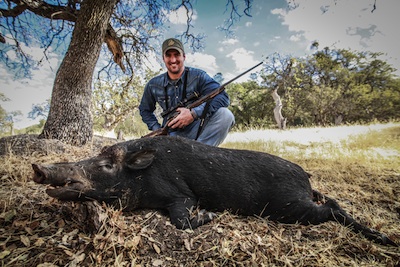 I pointed out my find to Doug Roth. It was a big boar, Roth told us, once he’d zeroed in his own binos. As the three of us watched the boar—myself, Roth, and Bear Pascoe, a group of maybe ten other hogs appeared above the boar on the hill but moving in the opposite direction.
I pointed out my find to Doug Roth. It was a big boar, Roth told us, once he’d zeroed in his own binos. As the three of us watched the boar—myself, Roth, and Bear Pascoe, a group of maybe ten other hogs appeared above the boar on the hill but moving in the opposite direction.
Pascoe and I were hunting Central Coastal California at the invitation of Weatherby. I was getting my first chance to use the rifle maker’s new Hog Reaper rifle on a pig hunt, and Pascoe was there as a part of Team Weatherby, the California rifle maker’s promotional effort to bring new and younger people to hunting and shooting.
I was also getting my first taste of long-range spot-and-stalk hog hunting, and this part of California was the perfect place for it. The terrain was rugged and steep, with many open spaces leading to hillsides covered in deep brush, and a good mix of trees, mostly red and white oaks and cedars.
We decided our best move was to put a stalk on the larger group and let the boar go his way. The plan was easy enough: drive a good mile and a half in the direction the sounder was heading, then strike out on foot, up and down the steep inclines and hopefully get ahead of the hogs.
A half hour later, after hiking up some treacherous slopes and breathing hard in the warm morning air, we found ourselves among some good-sized live oaks. I figured we’d missed the hogs. Roth had his worries, too. He told us we should probably veer hard left around (yet another!) big hill in front of us, get on the other side, and see if we could spot the hogs.
Pascoe and I cinched up our rifle slings and got ready to move out, when all three of us heard the tell-tale snorting of hogs, to our right and hundreds of yards away.
We made our way to a stand of white oaks, moving as quietly as we could, and spotted the group of hogs as they approached the trees. Pascoe was going to shoot first, and he stood to the right side of a big oak, me to the left. He lifted his rifle, and aimed it. I put my scope onto a decent sized pig closest to me. But when Pasco pulled his trigger on his Mark V rifle chambered in .300 Wby Mag, the pig I had in my scope hit the ground dead.
A melee of pig bodies kicked up dust, grunting and squealing in fright. I picked a hog running to my left at about 60 yards, my first shot missed, the bullet kicking up dirt just behind the pig. My second shot, I thought, was a miss also, but it actually hit the sow in the left rear leg, and turned her enough so that my next shot from the .308 Reaper took her broadside in the shoulder. She made it maybe 40 yards before dropping and dying.
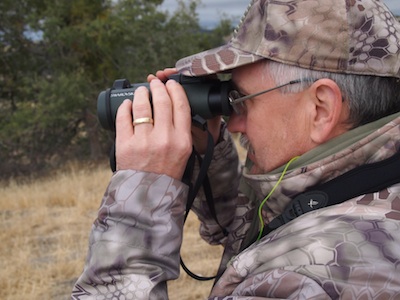 Successful spot-and-stalk hunting starts with the spotting part, and that means good quality binoculars. The Swarovski’s certainly fit the bill. The binos present clear, crisp images, sometimes appearing so close I very much misjudge the distances. When I spotted that black boar, for example, I asked Roth how far away it was: 1,000 yards or so?
Successful spot-and-stalk hunting starts with the spotting part, and that means good quality binoculars. The Swarovski’s certainly fit the bill. The binos present clear, crisp images, sometimes appearing so close I very much misjudge the distances. When I spotted that black boar, for example, I asked Roth how far away it was: 1,000 yards or so?
“More like a mile and a quarter,” was his response. “Maybe a mile and a half.”
Swaros are not inexpensive, and some hunters to do the, “Oh my gawd! You’re kidding me!!” when they ask the price and I tell them. Hey, I agree–$2,500 is a lot of money. And there are quality binoculars on the market for less. All I can say is, I’ve used this same pair on many, many hunts, all across the country and Canada, for hogs, elk, deer and other game, and they’ve never let me down. If the animal’s out there, on a clear day or cloudy, in good light or bad, the Swarovski’s pick it out.
Of course, to do successful spot-and-stalk you need to know the hogs, too, their movements and patterns. My hunt was in mid-November of last year, and it wasn’t getting much above the low 60’s during the day, and probably 15 degrees cooler at night. So the hogs, Roth told me, would be moving well into the morning to feed, traveling the hillsides and open spaces in search of feeding areas.
Even when they bedded down, they could still be spotted. These hogs like to carve out small sleeping depressions in the dirt. Glassing the hillsides, you look for a somewhat dug up area, with a black or off-colored spot in the middle. Hog!
Once you find a hog or hogs, then comes the stalk. If they are bedded down, you try to come at them from the downwind side and get in close enough for a shot.
If they are moving, the trick is to get far enough ahead of them in your vehicle, and then, as Pascoe and I did, try to cut them off on foot.
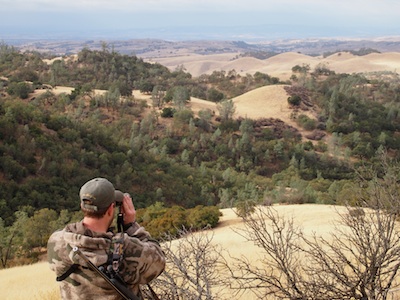 The next morning, Arizona Diamondback Willie Bloomquist, myself and our guide drove to different spots in the 50,000 acre ranch lease we were hunting, stopping along ridges and other high points where we could glass the areas below. On one of our stops Willie spotted a hog feeding under some trees and after a relatively short stalk, put down a nice sow at 270 yards using a Weatherby Mark V chambered in 30-378 Wby Mag.
The next morning, Arizona Diamondback Willie Bloomquist, myself and our guide drove to different spots in the 50,000 acre ranch lease we were hunting, stopping along ridges and other high points where we could glass the areas below. On one of our stops Willie spotted a hog feeding under some trees and after a relatively short stalk, put down a nice sow at 270 yards using a Weatherby Mark V chambered in 30-378 Wby Mag.
Bloomquist, by the way, is a dedicated hunter and he loves to shoot, practicing as much as his schedule allows. He proved his dedication on that shot!
The next day, hunting on my own with two of Roth’s guides, we spend a rainy afternoon locating different vantage points. We spotted a sounder of a dozen hogs that had rooted out a regular bunker under a tree maybe 400 yards away. We were planning out our stalk, when the sounder heard us, smelled us, or both, and 12 hogs jumped to their feet and sprinted up the hill. They topped the hill while we were getting into the truck, and went down the far side and nearly to the top of the next hill by the time we got the truck down the road and around the slope.
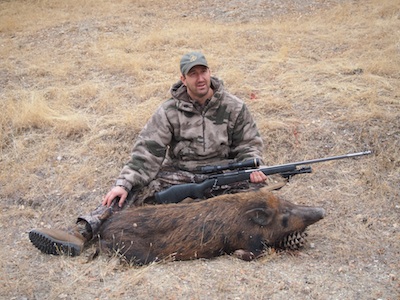 But spotting and stalking can be about your ears, too. Later that afternoon, we parked the truck on a hilltop, glassed for ten minutes, and then began walking down the graveled road. We were actually quite a ways downslope from the truck, unsuccessfully glassing the overgrown hills on either side when one of the guides said, “Did you hear something?”
But spotting and stalking can be about your ears, too. Later that afternoon, we parked the truck on a hilltop, glassed for ten minutes, and then began walking down the graveled road. We were actually quite a ways downslope from the truck, unsuccessfully glassing the overgrown hills on either side when one of the guides said, “Did you hear something?”
I didn’t, and neither did the second guide. But we glassed the rising slope to our right and eventually spotted a sow and a half-dozen small hogs. We saw some movement in the brush about 20 yards above, so I set up my shooting sticks, and got the Hog Reaper ready. Three boars stepped out of the brush, grunting and shoving at each other as they foraged.
And then he stepped out, the hog I had been hoping for: a black-and-white Dalmatian colored boar. The guides said for me to take any of the boars, it really didn’t matter as they were all about the same size. The range was 180 yards, and I had just lined up the scope’s crosshairs on the Dalmatian’s shoulder when one of the guides, still using his binoculars, said,
“You know what? That red boar’s actually bigger than the rest. Quite a bit.”
“Compared to this back and white guy?” was my question.
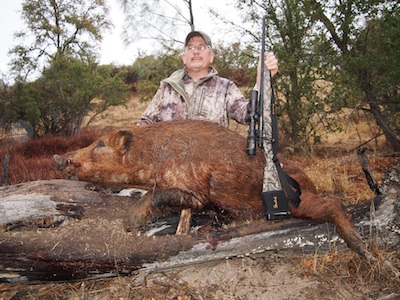 That decided it, bigger being better for me when it comes to boars. One shot from my Hog Reaper and the .308 Federal Vital-Shok bullet dropped Red right over; he slid downhill, DOA, while the other hogs ran upslope.
That decided it, bigger being better for me when it comes to boars. One shot from my Hog Reaper and the .308 Federal Vital-Shok bullet dropped Red right over; he slid downhill, DOA, while the other hogs ran upslope.
By the way, I could’ve taken another one or two hogs, including Mr. Black and White, as the hogs presented great shots while heading up that hill. Had I not been hunting in California! You see, California is the only state I know that requires you to have a tag for each pig you hunt. And with the red boar down, I had used up my two tags.
The red boar was, in fact, all of 230 pounds, and we had a lot of fun dragging him out of a tangled mess of brush and vines, and then several hundred yards to the truck. But he was a nice hog, at the time the largest boar I’d shot, and a great way to finish up my first California spot and stalk hog hunt.
On the Web:
Weatherby-X and the Hog Reaper:
http://www.weatherby.com/
Camp 5 Outfitters:
http://www.camp5outfitters.com/
Swarovski Optik:
http://www.swarovskioptik.com/hunting
Federal Ammunition:
http://www.federalpremium.com/

